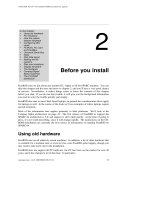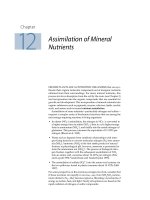plastics.pptCORETECH SYSTEMPlastics FundamentalsThis chapter will give you some understanding pot
Bạn đang xem bản rút gọn của tài liệu. Xem và tải ngay bản đầy đủ của tài liệu tại đây (1.83 MB, 33 trang )
1
C
C
ORE
ORE
T
T
ECH
ECH
S
S
YSTEM
YSTEM
plastics.ppt
Plastics Fundamentals
Plastics Fundamentals
This chapter will give you some understanding of the plastic materials in the
plastic industry.
You will learn :
•Characters of plastics
•Classification of plastic materials
•Applications of plastic materials
2
plastics.ppt
C
C
OR
E
OR
E
T
T
ECH
ECH
S
S
YSTE
M
YSTE
M
Characters of Plastic Materials
Characters of Plastic Materials
q Lightweight Material
) Density: 0.8-2.2g/cm
3
q Wide Range of Mechanical Properties
) Young’s modulus (1-100,000 N/mm
2
for elastomer-
GF/thermosets, for steel: 500,000 N/mm
2
)
q Easy Processability
) processing temperature < 400
o
C
q Modifiability by Additives
) Fillers, reinforcing materials, color pigments,
plasticizers, flame retardants, stabilizers
Today, plastics applications are found in almost all areas of life. They are
materials with extremely wide spectrum of properties.That’s the reason why their
applications are so intensive and extensive.
The characters of plastic materials are summarized briefly here.
Plastics are light. The density of plastics varies between 0.8 and 2.2 g/cm
3
. In
other words, they are lighter than common materials such as steels and ceramics.
The weight of plastic-made article is lighter than that of metal-made/ceramic-
made products.
Plastics exhibit a wide range of mechanical properties. They can be soft and
elastic as well as hard and rigid under different processing environment. Some
filler-reinforcing plastic material may exhibit a higher value of elastic module
than that of metal and can be applied for specific functions.
Plastics can be processed easily and economically. Most plastics can be
processed below 400
o
C .Thus we can produce complex plastic part simply
without consuming too much energy.
The properties of plastic materials can be modified by compounding. Additives
such as fillers, reinforcing materials, plasticizers, stabilizers can be added to
modify the processing properties of material or performance of product.
3
plastics.ppt
C
C
OR
E
OR
E
T
T
ECH
ECH
S
S
YSTE
M
YSTE
M
Characters of Plastic Materials
Characters of Plastic Materials
q Low Thermal and Electrical Conductivity
) k:0.1-1W/m/K,metal:100-1000W/m/K, thermal/electric
good insulator
q Transparency for Amorphous Plastics
) for lenses, CDs, optial discs
q High Chemical Resistance
) not susceptible to corrosion
q Permeable
) permit permeation and diffusion
q Recyclability and Reusability
The thermal and electrical conductivities of plastics are low, these properties
make them good thermal and electric insulators. On the other hand, the poor
thermal conductivity of plastics will produce some molding difficulties or
defects, such as hot spot and burning points.
Amorphous plastics such as PS are often transparent and can be colored as
desired. This character makes plastic a good candidate for optical article
production.
Plastics are inert to chemical and are not susceptible to corrosion problem. This
character is the reason why plastics have been applied to producing containers for
corrosive chemicals.
Sometimes the permeability of plastics make cause problem, such as in the
applications of IC-packing. Humidity permeation across the plastic packaging
may cause corrosion of electric circuits interior the package. However, in some
applications, such as application in membrane, this character is essential.
Thermoplastics are remeltable and can be recycled and reused.
4
plastics.ppt
C
C
OR
E
OR
E
T
T
ECH
ECH
S
S
YSTE
M
YSTE
M
Introduction to Plastic Materials
Introduction to Plastic Materials
q A polymer molecule (macromolecule) is a long,
large chain composed of many small simple
chemical units (structural units)
Macromolecule
branch
Structural Unit
A plastic material is composed of polymer chains. Each chain is composed of
many repeated simple chemical units (structural units). Macroscopic behavior of
plastic material is determined by its microstructure. This difference in
microstructure characters between plastic materials and the small molecules
(such as that of air or water) causes the difference in their macroscopic behavior.
5
plastics.ppt
C
C
OR
E
OR
E
T
T
ECH
ECH
S
S
YSTE
M
YSTE
M
Example of a Polymer Molecules
Example of a Polymer Molecules
H
H
C
C
H
H
manomer
Ethylene: CH
2
=CH
2
M.W.=28
polymerization
LDPE (Low-Density PolyEthylene): -(CH
2
-CH
2
)
n
-
polymer
M.W.=280,000
The basic substances used in producing plastics are called “monomers”
(mono=single, meros=part). The macromolecules of plastics are formed by
chemical linking manomers. This chemical reaction is called polymerization
process because a polymer (poly=many) molecule is produced from monomers.
For example, a low density polyethylene (LDPE) molecule is produced from
the combination of many thousands of ethylene manomer molecules. The
molecular weight of a ethylene manomer is 28 whereas the molecular weight of a
LDPE is about 280,000.
6
plastics.ppt
C
C
OR
E
OR
E
T
T
ECH
ECH
S
S
YSTE
M
YSTE
M
Simple Molecules vs.
Simple Molecules vs.
Macromolecules
Macromolecules
Simple Molecules
e.g.,water
liquid near the rotating rod
is push outward by the
centrifugal force
The microstructure of materials may effect their macroscopic behavior. For
simple molecules such as water molecules (composed of one oxygen atom and
two hydrogen atoms), their response to external force is fast due to the high
molecular mobility and high freedom of changing molecule configuration.
For example, if we insert a rotating rod into a baker containing water, we see
that the liquid near the rotating rod is push outward by the centrifugal force, and a
dip in the liquid surface near the center of the baker result.This behavior is typcal
for liquids consisting of simple molecules.
7
plastics.ppt
C
C
OR
E
OR
E
T
T
ECH
ECH
S
S
YSTE
M
YSTE
M
Simple Molecules vs.
Simple Molecules vs.
Macromolecules
Macromolecules
Polymer Molecules
entanglement between polymer chains
polymeric liquid moves
toward the center of the
baker and climbs up the
rotating rod
Weissenberg Effect
(Rod-Climbing Effect)
On the other hand, when the rod is rotated, the polymeric liquid will moves in
the opposite direction, toward the center of the baker and climbs up the rotating
rod. This rod-climbing phenomena is referred to as the Weissenberg effect.
The Weissenberg effect is attributed to the normal stress difference arising from
the chain-like microstructure of polymeric liquid. The entanglement between
polymer chains and flow-induced anisotropic microstructure cause the plastic
material to exhibit nonlinear normal stress behavior.
Intuitively, you may think Weissenberg effect is a result of polymer chains
climb the rotating rod as they are entangled with each other.
8
plastics.ppt
C
C
OR
E
OR
E
T
T
ECH
ECH
S
S
YSTE
M
YSTE
M
Simple Molecules vs.
Simple Molecules vs.
Macromolecules
Macromolecules
Simple Molecules
e.g.,water
shear rate
Shear Viscosity
lower temperature
higher temperature
viscosity = f( composition, T,P )
Newtonian Viscosity
Viscosity is a measure of the resistance to flow. Low-molecular-weight fluids
(composed of simple molecules) exhibit a so-called Newtonian viscosity and they
are referred to as Newtonian fluids. The viscosity of a Newtonian fluid is
independent of deformation rate and depends only on its composition,
temperature and, to a much lesser extent, on pressure.
Typically, low-molecular-weight liquids and all gases are Newtonian fluids,
that is, they have constant viscosity under constant temper-ature and pressure
condition. This type of flow behavior would be expected for small molecules,
where the structure, and therefore the resistance to flow, does not change with th
intensity of shearing.
Note that the Newtonian viscosity is a decreasing function of temperature for
the liquids, and in some cases the temperature dependence is very strong.
9
plastics.ppt
C
C
OR
E
OR
E
T
T
ECH
ECH
S
S
YSTE
M
YSTE
M
Simple Molecules vs.
Simple Molecules vs.
Macromolecules
Macromolecules
Polymer Molecules
shear rate
Shear Viscosity
lower temperature
higher temperature
viscosity = f( composition, T,P,shear rate )
Non-Newtonian Viscosity
(Shear-Thinning Effect)
On the other hand, polymeric liquids with chain-like microstructure are non-
Newtonian in that the viscosity changes with changing shear rate ( that is, rate of
deformation).
Polymer melts and solutions are non-Newtonian and are referred to be
pseudoplastic (shear-thinning) fluids because their viscosity (hence resistance to
flow) decreases with the intensity of shearing.
The shear-thinning behavior of polymeric liquids will be given in next section.
In addition, the shear-thinning viscosity also depends on composition,
temperature, as well as pressure. The temperature-dependence of polymer
viscosity plays a key role in polymer processing operations.
10
plastics.ppt
C
C
OR
E
OR
E
T
T
ECH
ECH
S
S
YSTE
M
YSTE
M
Shear Rate
Viscosity
Shear
Shear
-
-
Thinning Viscosity of
Thinning Viscosity of
Polymeric Liquids
Polymeric Liquids
increasing Temperature
The shear-thinning behavior of polymeric liquids can be interpreted in terms of
their molecular structure.
At low shear rate, the randomizing (disorienting) effect of the thermal
fluctuation of the chain segments overcomes any tendency toward molecular
alignment in the shear field. The molecules are thus in their most random and
highly entangled state, and have their greatest resistance to slippage (flow). This
explains why they exhibit higher viscosity under low shear rate condition.
As the shear rate is increased, the molecules will begin to untangle and align in
the shear field, reducing their resistance to slippage past one another. Thus the
viscosity will decrease with increasing shear rate because the increasing
orientating behavior of molecular chains.
At very high shear rates orientation of molecular chains may be complete and
in this range near-Newtonian behavior may be observed. Intense shearing will
eventually lead to extensive breakage of main-chain bonds of polymer
microstructure and mechanical degradation of material.
In injection molding the shear rate has a range of about 100 to 10,000 sec
-1
,most plastics will exhibit a shear-thinning viscosity in this shear-rate change.
The shear-rate-dependent viscosity behavior of plastic materials also play a key
role in the polymer processing operations.
11
plastics.ppt
C
C
OR
E
OR
E
T
T
ECH
ECH
S
S
YSTE
M
YSTE
M
Macromolecular Structure vs.
Macromolecular Structure vs.
Macroscopic Properties
Macroscopic Properties
Pro
p
ert
i
es Dens
i
t
y
(
g
/
c
m
3
)
Cr
y
sta
l
l
i
n
i
t
y
(
%
)
M
e
l
t
i
n
g
Po
i
nt
(
o
C
)
T
ens
i
l
e
M
od
u
l
u
s
(
N
/m
2
)
LDPE
0.910~0.925 60~70 110~120 0.97~2.6x10
8
M
DPE
926~0.940 70~80 120~130 1.7~3.8x10
8
H
DPE
941~0.965 80~95 130~136 4.1~12.4x10
8
LLDPE
0.900~0.920 90
LDPE: Low-Density PolyEthylene, MDPE: Medium-Density PolyEthylene,
HDPE: High-Density PolyEthylene, LLDPE: Linear Low-Density PolyEthylene
long side chains branching
linear molecules,
4~10 short side chains/1000 C atoms
linear molecules,
10~35 short side chains/1000 C atoms
The macroscopic properties of plastics are influenced by their micro-structure.
For example, the degree and type of side branching along the main chain directly
affect the structure of the polymer and its properties.
Low-density polyethylene (LDPE,density=0.915 g/cm
3
) has a lower density
value since it is composed of long side chains. These long chains will hinder
themselves from packing together and forming crystalline area.
On the other hand, high-density polyethylene (HDPE,density=0.97 g/cm
3
) is
composed of short side chains. The molecular chains in HDPE are packed
together more efficiently and tightly. Thus the density and crystallinity of HDPE
are higher than that of MDPE and LDPE.
LLDPE has the lower density of LDPE but the toughness of HDPE. The highly
branched side-chains in its microstructure prevent the main chain from closely
packing and result in lower density.
12
plastics.ppt
C
C
OR
E
OR
E
T
T
ECH
ECH
S
S
YSTE
M
YSTE
M
Characters of
Characters of
Macromolecular Structure
Macromolecular Structure
q Great Diversity in Structure
q Large Molecular Weight (MW) and Molecular
Weight Distribution (MWD)
q Large Number of Internal Degree of Freedom
Polymer molecules differ from the small molecules in several ways. We will
discuss three key features of microstructure of polymers. These key features
make the macroscopic properties of plastic materials quite different from that of
common materials.
13
plastics.ppt
C
C
OR
E
OR
E
T
T
ECH
ECH
S
S
YSTE
M
YSTE
M
Macromolecular Structure
Macromolecular Structure
q Great Diversity in Structure
straight chain
branched chain
°Back
block copolymer
grafted copolymer
closed-ring polymer
rigid polymer
Much work has been devoted to synthesize and polymerize different types of
polymer materials.There are dosens of classes of polymers and thousands of
variants commercially available today. Plastics exhibit a wide, variable spectrum
of macroscopic properties owing to their diversity in microstructure.
Example of straight chain polymer: HDPE
Example of branched chain polymer: LDPE
Example of block copolymer: ethylene oxide and propylene oxide
Example of grafted copolymer: PVC/PMMA copolymer
14
plastics.ppt
C
C
OR
E
OR
E
T
T
ECH
ECH
S
S
YSTE
M
YSTE
M
Macromolecular Structure
Macromolecular Structure
q Large Molecular Weight (MW)
) Typical MW of synthetic polymer :10
4
~10
6
g/mol
Compound No. Atoms M.W.
Low Molecular Weight Compound
water, H
2
O 3 18
ethylene,C
2
H
4
6 28
alcohol, C
2
H
5
OH 9 46
lime, CaCo
3
5 100
Polymeric Compound
Nylon 4000 23,000
polyethylene 10,000 280,000
Natural Rubber 50,000-60,000 400,000
°Back
The molecular weight of a compound is defined as the weight,in grams, for
every mole of that species. For example, the molecular weight of carbon is 12,
since 6.023x10
23
C-atoms weight exactly 12g. A water molecule is composed of
three atoms (one oxygen and two hydrogen atoms) and its molecular weight is
18. The molecular weight of lime and alcohol are 100 and 46, respectively.
Polymeric compound is composed of macromolecules. These macromolecules
result from the chemical linking of many thousands of monomer molecules. For
example,a polyethylene (PE) polymer having about 10,000 repeat structural units
has a molecular weight of about 280,000.
The properties of polymeric material are strongly linked to the molecular
weight of the polymer.
15
plastics.ppt
C
C
OR
E
OR
E
T
T
ECH
ECH
S
S
YSTE
M
YSTE
M
Macromolecular Structure
Macromolecular Structure
q Long Molecular Chain
Ethylene
M.W.=28
molucular length=0.005
µ m
polymerization
PolyEthylene (PE)
M.W.=280,000
deg.poly.=10,000
°Back
molucular length=6.8
µ m
) Increase length :13,600 times
Polymer is produced by the polymerization reaction of monomers.
Polymerization is the chemical reaction that links structural units (monomers)
together.Molecular weight of a polymer is determined by the degree of
polymerization. The higher the degree of polymerization , the larger the
molecular weight of the polymer.
For example, ethylene, C
2
H
4
,has a molecular weight of 28 and a molecular
length of 0.005x10
-6
m. If the ethylene molecule was manified 10
6
times, it would
be approximately 5mm long.
On the other hand, a polyethylene produced from ethylene manomers has about
10,000 repeat units and a molecular weight of about 280,000. If it was fully
extended and mannfied 10
6
times, this polyethylene molecule will be 6.8 meter
long.
16
plastics.ppt
C
C
OR
E
OR
E
T
T
ECH
ECH
S
S
YSTE
M
YSTE
M
Macromolecular Structure
Macromolecular Structure
q Molecular Weight Distribution (MWD)
°Back
monomer
polymerization
low degree of polymerization
short molecular length
low molecular weight
high degree of polymerization
long molecular length
high molecular weight
)A polymer consists of a mixture of molecules with different
degree of polymerization (length of molecular chain)
Polymerization is a series of random reactions occuring on a macroscopic scale.
As a result, on the whole, polymer chains grow in a different rate and result in
different molecular length at any time in the polymerization proces.
At the end of polymerization, the number of monomers used to produce each
chain will vary substantially from chain to chain. Longer chain (with a higher
degree of polymerization)has a higher value of molecular weight whereas shorter
chain (with a lower degree of polymerization) has a lower one.
A plastic material is in fact consists of a mixture of molecules with different
molecular weight. Molecular weight distribution specifies the fraction of
molecules at each size level in a sample. A number of experimental techniques,
such as GPC (Gel-Permeation Chromato-graphy ), have been developed to
measure the molecular weight distribution of plastic materials.
17
plastics.ppt
C
C
OR
E
OR
E
T
T
ECH
ECH
S
S
YSTE
M
YSTE
M
Macromolecular Structure
Macromolecular Structure
q Molecular Weight Distribution (MWD)
polydispersity index (PI) or disperity index (DI)
PI
M
M
w
n
≡
M.W.
Fraction
polydisperse
PI>2
°Back
M.W.
Fraction
monodisperse
PI~1
The shape of the molecular weight distribution curve and the location of the
maximum value are very important, since most polymer physical properties can
be related in some way to this distribution.
Monodisperse distribution indicates most constituent molecules are of the same
size. On the other hand, polydisperse distribution represents that the polymer is
composed of a mixture of molecules with rather different chain lengths.
Polydispersity index (PI) or dispersity index (DI) is defined as the ratio of
weight average to number molecular weights. It is used to character a specific
polymer molecular weight distribution.
For an ideal monodisperse(all molecules the same size) polymer, the PI value
equals to one. Carefully fractioned or anionic addition polymers has a PI value of
1.02
Most commerical plastics have a polydisperse molecular weight distribution and
have PI values larger than 2. Values of 3 to 8 are not uncommon, with special
purpose polymer having values as large as 30.
18
plastics.ppt
C
C
OR
E
OR
E
T
T
ECH
ECH
S
S
YSTE
M
YSTE
M
Macromolecular Structure
Macromolecular Structure
q Large Number of Internal Degree of Freedom
stretch
slide
entanglement
crosslinking
Since plastic materials contain molecular weight in millions, each molecule in
the material is capable of existing in a huge number of configurations. These
configurations include chain stretching, sliding, entangling, crosslinking
(chemical joining), and so on.
Always keep in mind that a macroscopic property is a result of averaging all the
possible microscopic molecular configurations.
19
plastics.ppt
C
C
OR
E
OR
E
T
T
ECH
ECH
S
S
YSTE
M
YSTE
M
Effect of Molecular Weight
Effect of Molecular Weight
°Next
Molecular Weight
Stiffness, Strength,
PS: deg. polym.=1,000
stiff and brittle at room temp.
PS: deg. polym.=10
sticky and soft at room temp.
The mechanical behavior of the plastic material is influenced by its molecular
weight. For example, polystyrene with a degree of polymerization 1,000 is stiff
and brittle at room temperature; whereas polystyrene with a degree of
polymerization 10 exhibits a sticky and soft property at room temperature.
20
plastics.ppt
C
C
OR
E
OR
E
T
T
ECH
ECH
S
S
YSTE
M
YSTE
M
Effect of Molecular Weight
Effect of Molecular Weight
log( Molecular Weight )
log( Viscosity )
slope=1
slope=1
molecular entanglements begin
to dominate the rate of slippage
of the molecules
°Back
The length of molecular chain is described by the molecular weight. A larger
molecular weight indicates a longer chain length.This results in a more molecular
entanglements and leads to a greater resistance to slippage (flow), hence causes a
higher value of viscosity.This is a molecular interpretation of why a polymer’s
weight exerts a strong influence on the melt or concentrated solution viscosity.
Note that the dependence on molecular weight changes when a critical
molecular weight is reached. This critical point is thought to be the point at which
molecular entanglements begin to dominate the rate of slippage of the molecules.
When the molecular weight exceeds this critical value, the viscosity increases
sharply and leads to greater flow resistance.
21
plastics.ppt
C
C
OR
E
OR
E
T
T
ECH
ECH
S
S
YSTE
M
YSTE
M
Effect of
Effect of
Molecular Weight Distribution
Molecular Weight Distribution
Shear Rate
Viscosity
wide MWD
narrow MWD
short chain molecules act as
a lubricant(filler particles)
similar molecular size,
marked Newtonian range
and higher viscosity
°Back
Changes in the molecular weight distribution causes shihts in the Newtonian
flow range.
With a wide molecular weight distribution, the short-chain molecules have the
effect of a lubricant and longer chain molecules may swim along the melt, similar
to filler particles system.
In the case of narrow molecular weight distribution, all molecular chains are of
the similar size and no short chain molecule acts as a lubricant, hence lead to a
marked Newtonian flow range and a higher value of viscosity.
22
22
plastics.ppt
C
C
OR
E
OR
E
T
T
ECH
ECH
S
S
YSTE
M
YSTE
M
Classification of Plastics
Classification of Plastics
Amorphous (Semi)crystalline
Thermoplastics
not crosslinked
Slightly
Crosslinked
Strongly
Crosslinked
Elastomers/Thermosets
cross-linked
PLASTICS
PC,PS,PVC,
PMMA,
HDPE,LDPE,
PP,PA,POM,
PTFE
,thermoplastics
PUR,
Polybutadiene,
Natural Rubber
,elastomers
Epoxy,Melamine,
Phenolics,
Polyester,
,thermosets
Plastics can be classified according to several criteria. If we make the
classification according to chemical structure of plastics, two categories can be
obtained: thermoplastics and thermosets/ elastomers.
Thermoplastics are those polymers that have no crosslinking microstructure.
They are meltable under high temperature and soluble in many solvents.
Thermoplastics can further be divided into two classics: amorphous and
crystalline (or semicrystalline) polymers.
Thermosets are those polymers that have strong crosslinking network structure.
They cannot be melted repeatly once they have been solidified.
Elastomers are only lightly cross-linked which permits almost full extension of
the molecules. They cannot be melted or dissolved, but they can be swelled in
organic solvents.
23
plastics.ppt
C
C
OR
E
OR
E
T
T
ECH
ECH
S
S
YSTE
M
YSTE
M
Thermoplastics
Thermoplastics
q Microstructure:
) No chemical connection (crossliking) between molecules
) Held chains together by intermolecular forces and physical
entanglement
q Properties:
) Meltable,Moldable
) Soluble
) Variety in property at room temperature
°Next
Thermoplastics (“thermo”=heat,”plastic”=shapable) are those polymers that
have no chemical cross-linking structure. Molecular chains in a thermoplastics
are hold together by intermolecular forces and physical entanglements. These
rather weak bonding forces can be overcomed upon heating, hence thermoplastics
are meltable and moldable. That is, they have the ability to flow as the
intermolecular forces are broken and the molecules are able to slide past each
other with ease.
Thermoplastics can be melted repeatedly and are soluble in suitable solvents.
Because the intermolecular forces depends on many factors such as the type and
number of branches or side chains, their mechanical properties vary from a soft
condition to a ductile or hard and brittle at room temperature.
24
plastics.ppt
C
C
OR
E
OR
E
T
T
ECH
ECH
S
S
YSTE
M
YSTE
M
Classification of Thermoplastics
Classification of Thermoplastics
Crystalline or
Crystalline or
Semicrystalline
Semicrystalline
slightly branching, linear
or very ordered regular
branching chains
crystalline regions:
orderly arranged
tightly packed chains
Examples:
HDPE,LDPE,PP,PA,
POM,PTFE
Amorphous
Amorphous
highly branching
or long side chains
or large functional group
cannot form orderly
arranged region,
unstructured
Examples:
PC,PS,PVC,
PMMA,
°Next
Thermoplastics can be divided into two subcategories according to the order of
molecules arrangement: crystalline and amorphous polymers.
Crystalline polymers are those with a certain order in their molecular structure.
Their molecular chains exhibit only slightly branching (I.e.,only a few short side
chains), or very ordered regular branching and some orderly arranged regions
(crystalline regions) exist within the material. Within the crystalline regions the
molecular chains are arranged orderly and are packed tightly. In reality, no 100%
crystalline polymer can be produced. Some amorphous regions will exist where
molecular chain arrangement is less ordered or disordered. Polymers with a non-
100% degree of crystallinity are referred to be as semi-crystalline polymers.
Plastics with highly branched chains, long side chains, or lagre functional group
(side chain chemical group) are hard to arrange molecular chains in an ordered
and tightly structure. These unstructured polymers are referred to be as
amorphous (=have no definite form) polymers. Since they are always crystal
clear in the unpigment condition, they are also called synthetic or organic glasses.
25
plastics.ppt
C
C
OR
E
OR
E
T
T
ECH
ECH
S
S
YSTE
M
YSTE
M
Temperature
Specific Volume
Morphology of Thermoplastics:
Morphology of Thermoplastics:
Amorphous and Semi
Amorphous and Semi
-
-
Crystalline
Crystalline
Semi-Crystalline
Melting State
Amorphous
The molecules in crystalline/semi-crystalline thermoplastic polymers exist in a
more regular and ordered fashion. The mobility of the molecular chains continue
to increased with heating. The molecules in the amorphous regions are the first to
slide and those molecules in the crystalline regions continue to fluctuate with
adding thermal energy. Upon exceeding the crystallite melting temperature, the
intermolecular forces within the crystalline regions can no longer constrain the
molecular chains to slide. The crystalline regions begin to melt and cause a step
change in the specific volume because these ordered structures have been
destroyed.
Amorphous polymers are unstructured and have no significant melting point.
An increase in temperature causes the molecules to vibrate and cause the plastics
to become softer. With a further increase in temperature, the plastics exceeds the
flow temperature and enters the melt state. Amorphous polymers have no distinct
melting point. They soften and exhibit a variation in specific volume within a
temperature range.
In melting state the polymer is able to flow. The microstructure is essentially
amorphous because the high mobility of molecular chains.









